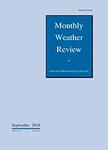版权所有:内蒙古大学图书馆 技术提供:维普资讯• 智图
内蒙古自治区呼和浩特市赛罕区大学西街235号 邮编: 010021

作者机构:Univ Wisconsin Madison Cooperat Inst Meteorol Satellite Studies Madison WI USA Univ Oklahoma Cooperat Inst Mesoscale Meteorol Studies Norman OK 73019 USA NOAA OAR Natl Severe Storms Lab Norman OK USA Penn State Univ Dept Meteorol 503 Walker Bldg University Pk PA 16802 USA
出 版 物:《MONTHLY WEATHER REVIEW》 (天气月评)
年 卷 期:2016年第144卷第9期
页 面:3159-3180页
核心收录:
学科分类:07[理学] 070601[理学-气象学] 0706[理学-大气科学]
主 题:Observational techniques and algorithms Radars/Radar observations Satellite observations Sensitivity studies Forecasting Short-range prediction Models and modeling Data assimilation Numerical weather prediction/forecasting
摘 要:This study uses an observing system simulation experiment to explore the impact of assimilating GOES-R Advanced Baseline Imager (ABI) 6.95-mu m brightness temperatures and Weather Surveillance Radar-1988 Doppler (WSR-88D) reflectivity and radial velocity observations in an ensemble data assimilation system. A high-resolution truth simulation was used to create synthetic radar and satellite observations of a severe weather event that occurred across the U.S. central plains on 4-5 June 2005. The experiment employs the Weather Research and Forecasting Model at 4-km horizontal grid spacing and the ensemble adjustment Kalman filter algorithm in the Data Assimilation Research Testbed system. The ability of GOES-R ABI brightness temperatures to improve the analysis and forecast accuracy when assimilated separately or simultaneously with Doppler radar reflectivity and radial velocity observations was assessed, along with the use of bias correction and different covariance localization radii for the brightness temperatures. Results show that the radar observations accurately capture the structure of a portion of the storm complex by the end of the assimilation period, but that more of the storms and atmospheric features are reproduced and the accuracy of the ensuing forecast improved when the brightness temperatures are also assimilated.